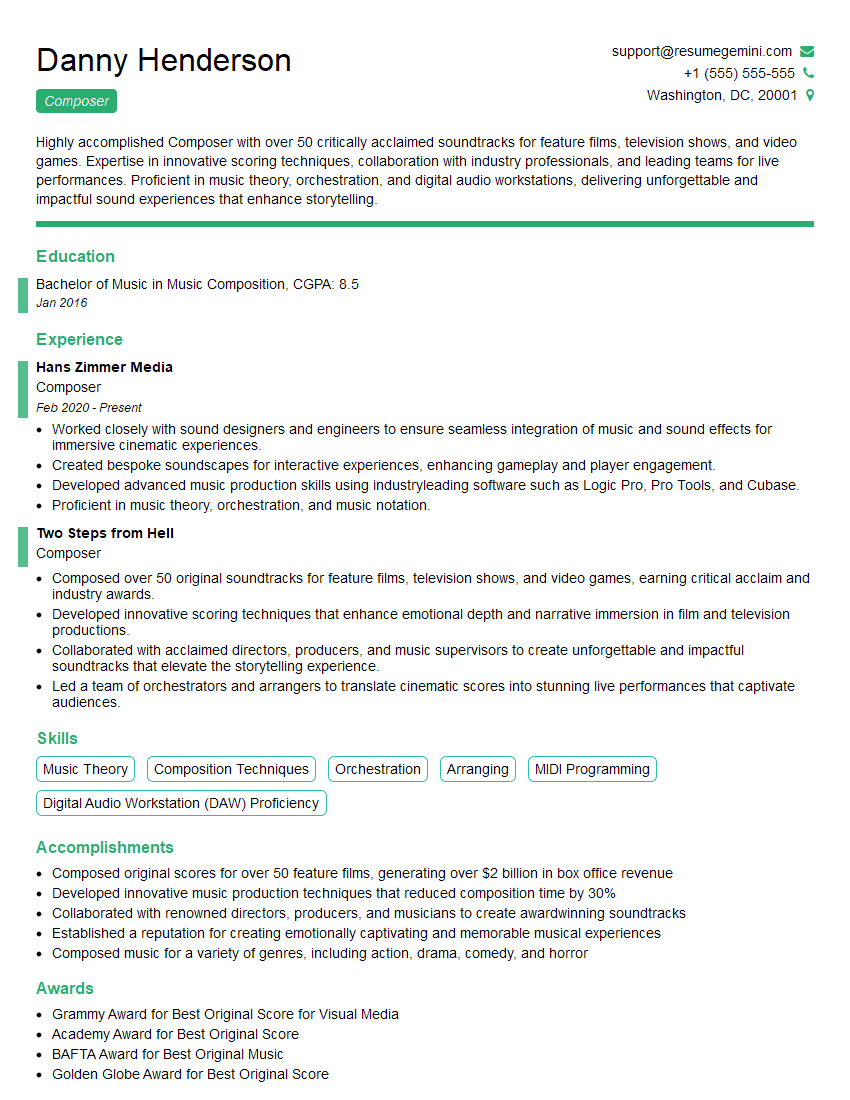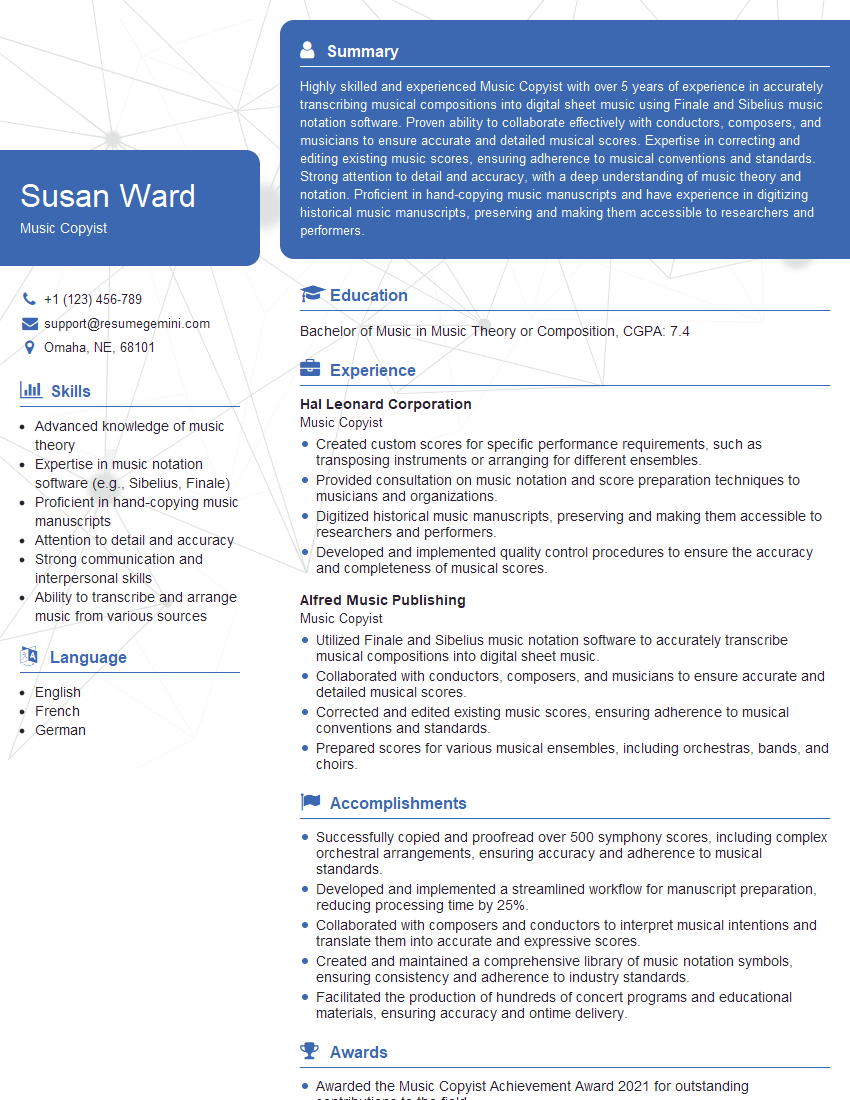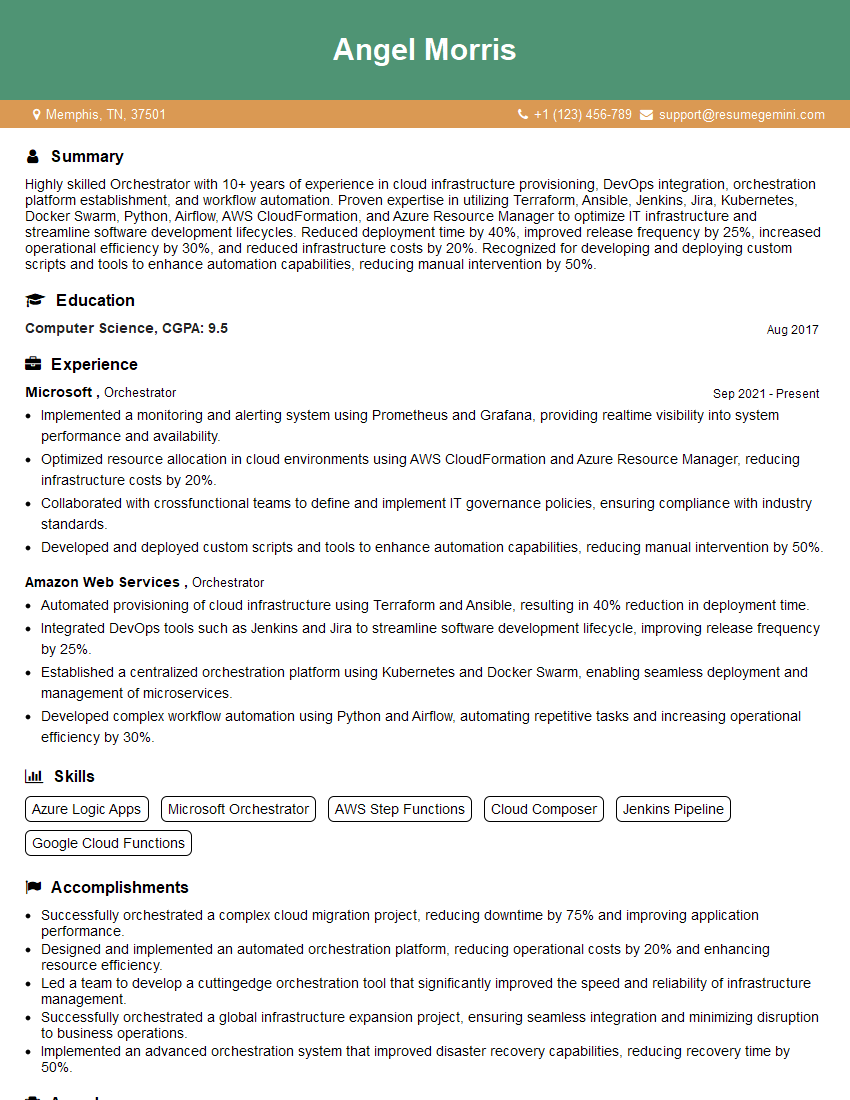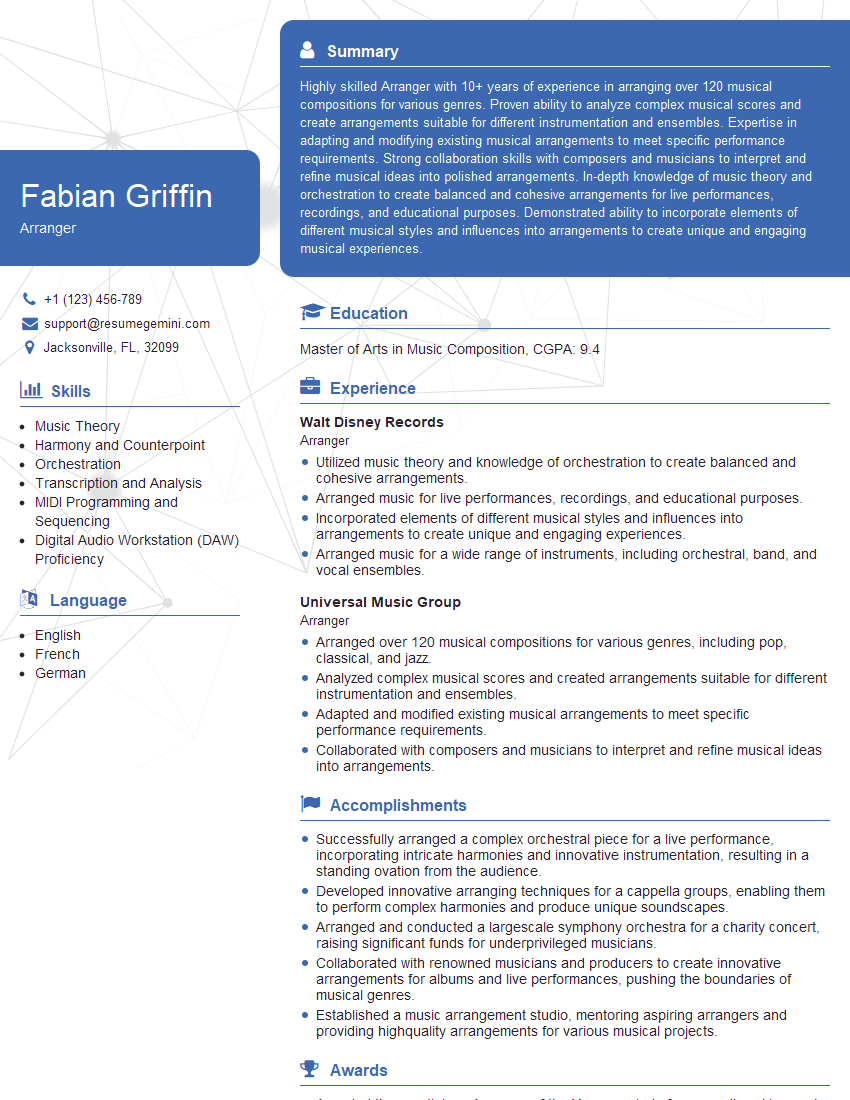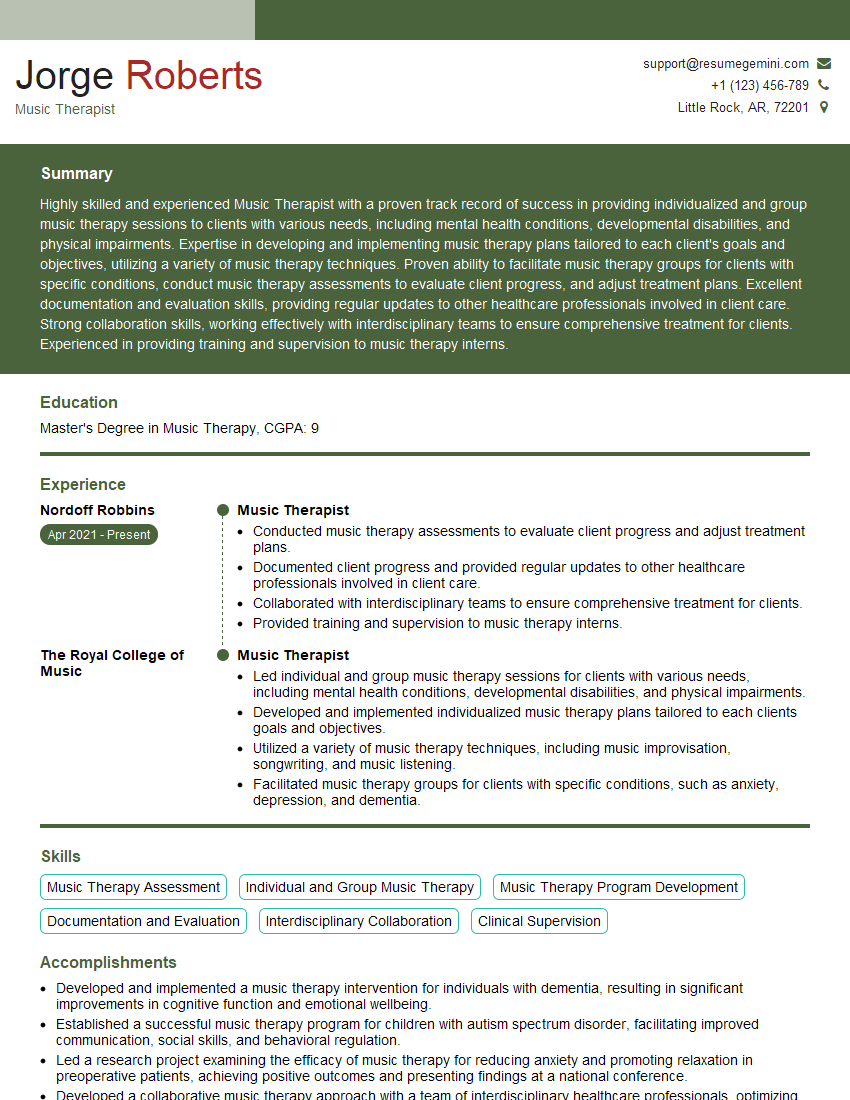Unlock your full potential by mastering the most common Music Theory Counterpoint interview questions. This blog offers a deep dive into the critical topics, ensuring you’re not only prepared to answer but to excel. With these insights, you’ll approach your interview with clarity and confidence.
Questions Asked in Music Theory Counterpoint Interview
Q 1. Define counterpoint and its various types (e.g., two-part, three-part, etc.).
Counterpoint is the art of combining two or more independent melodic lines (voices) in a harmonious and interesting way. Think of it like a conversation between melodies, each with its own character and personality, yet working together to create a unified whole. The number of voices determines the type of counterpoint. Two-part counterpoint involves two melodic lines, three-part counterpoint involves three, and so on. The complexity increases with each added voice, demanding more careful consideration of voice leading and overall texture.
- Two-part counterpoint: The simplest form, focusing on the interplay between two independent melodies.
- Three-part counterpoint: Adds a third voice, increasing harmonic possibilities and textural richness, but also introducing new challenges in maintaining independence and avoiding undesirable clashes.
- Four-part counterpoint: Often used in choral and orchestral writing, offering greater complexity and opportunities for sophisticated harmonic progressions.
- More than four parts: While less common in traditional counterpoint studies, techniques are extended to accommodate even larger ensembles. This often involves dividing the voices into groups or sections.
Q 2. Explain the concept of species counterpoint.
Species counterpoint is a systematic approach to learning counterpoint, focusing on specific melodic intervals and rhythmic relationships between voices. It’s like learning grammar before writing a novel – it provides a structured foundation for more advanced compositional techniques. Each species (or type) establishes progressively more complex rules and freedoms, building upon previously learned concepts. Beginning with simple intervals and note values, it gradually introduces more complex rhythmic patterns and harmonic relationships, allowing for a comprehensive understanding of voice leading and texture.
Imagine learning to write sentences before composing a full essay; species counterpoint is that ‘sentence construction’ of counterpoint.
Q 3. Describe the rules governing voice leading in two-part counterpoint.
Rules governing voice leading in two-part counterpoint are crucial for creating pleasing and functional music. They primarily focus on preventing clashes and maintaining melodic independence. Key rules include:
- Avoid parallel perfect intervals: Parallel fifths and octaves (two voices moving in the same direction to create a perfect fifth or octave) are generally avoided, as they create a sense of monotony and weaken the harmonic structure.
- Avoid direct fifths and octaves: This means consecutive perfect fifths or octaves in the same two voices. The leading voice must never jump into a perfect fifth or octave with the other voice, only approach it gradually.
- Maintain melodic independence: The two voices should have distinct melodic character and contour. Avoid too much imitation or parallelism between the lines.
- Use stepwise motion predominantly: While leaps are allowed, excessive leaps can disrupt the flow and make the counterpoint sound awkward. Stepwise motion is smoother and more natural.
- Consider the melodic and harmonic context: The specific notes and intervals used should be chosen to support the overall harmonic progression and the musical ideas being expressed.
Q 4. How do you handle parallel fifths and octaves in counterpoint?
Parallel fifths and octaves are generally considered undesirable in counterpoint because they create a sense of monotony and weaken the harmonic interest. They need to be avoided. The strategies to handle them depend on the context.
- Alter one voice: The most common solution is to slightly alter the melodic contour of one of the voices, perhaps by changing a note or altering its rhythm, to break the parallel motion. This can be a small adjustment, and often resolves the issue.
- Use contrary motion: If the voices are moving in parallel motion, try to make them move in contrary motion (one voice goes up, the other goes down), which often resolves the parallel interval.
- Use oblique motion: One voice remains the same note while the other moves; this can sometimes be used, although it’s not always the ideal solution.
Learning to identify and resolve parallel fifths and octaves is a fundamental skill in counterpoint.
Q 5. Explain the difference between direct and oblique motion.
Direct motion and oblique motion describe how two voices move in relation to each other.
- Direct motion: Both voices move in the same direction (both up or both down). While sometimes acceptable in small intervals, direct motion of perfect intervals (fifths and octaves) is generally avoided, as previously discussed.
- Oblique motion: One voice remains on the same pitch while the other moves. This can be a useful technique to resolve dissonances or maintain a specific harmonic function. It is frequently used as a transitional technique.
Understanding these types of motion is essential for controlling the flow and harmonic progression of your counterpoint.
Q 6. What are the characteristics of good counterpoint writing?
Good counterpoint writing strives for a balance of independence, unity, and harmonic interest. Characteristics include:
- Melodic Independence: Each voice should have its own character and clear melodic contour. They shouldn’t sound too similar or too dependent on each other.
- Harmonic Interest: The combination of voices should create rich and varied harmonic progressions. Avoid monotony.
- Smooth Voice Leading: Avoid abrupt leaps and awkward transitions. The voices should move smoothly and naturally.
- Avoidance of Parallel Fifths and Octaves: As previously discussed, these are typically avoided for their weakening of the harmonic interest.
- Appropriate Rhythmic Variety: The rhythmic patterns in each voice should be varied and interesting but should support the overall flow of the music. Avoid being monotonous.
- Structural Coherence: The counterpoint should have a clear structure and overall direction. The melodic and harmonic elements should work together to create a unified and satisfying musical experience.
Q 7. How do you apply contrapuntal techniques in composition?
Contrapuntal techniques are applied in composition to create complex and interesting textures, often adding depth and sophistication to a musical work. It’s not simply about adding voices; it’s about creating independent yet interwoven musical lines.
- Developing melodic ideas in multiple voices: A single melodic idea can be developed and transformed across different voices, adding to its overall expressiveness.
- Creating imitative counterpoint: One voice imitates another, creating a sense of unity and interplay.
- Using counterpoint to create harmonic interest: The combination of voices can produce rich and varied harmonic progressions, adding depth to the overall texture.
- Incorporating different species counterpoint: Using different species allows for gradual building of complexity and textural variety in the music.
- Working with different textures: Counterpoint can be used to create a variety of textures ranging from homophonic (one main melody with accompaniment) to polyphonic (multiple independent melodies).
Composers use contrapuntal techniques to create music with increased depth, beauty, and complexity. Mastering counterpoint allows for significantly more expressive and multifaceted compositions.
Q 8. Discuss the role of dissonance and consonance in counterpoint.
Dissonance and consonance are fundamental concepts in counterpoint, determining the harmonic stability and tension within a musical composition. Consonance refers to intervals that sound stable and pleasing to the ear, creating a sense of resolution. Common consonant intervals include perfect unisons, octaves, perfect fifths, and perfect fourths, as well as major and minor thirds and sixths. Dissonance, conversely, refers to intervals that sound unstable and create tension, requiring resolution to a consonant interval. Tritones (augmented fourths/diminished fifths), major seconds, and minor sevenths are examples of dissonant intervals. In counterpoint, the skillful interplay between dissonance and consonance is crucial for creating engaging and expressive music. Dissonance is used to create tension and anticipation, while consonance provides moments of rest and resolution. The effective use of dissonance and consonance depends on the context – a late Renaissance composer might have different approaches than a Baroque composer.
Think of it like storytelling: consonance is like a peaceful moment in the narrative, while dissonance is the exciting climax or a moment of suspense. The interplay of both keeps the listener engaged.
Q 9. Explain the concept of imitation in counterpoint.
Imitation in counterpoint involves one melodic voice echoing another, creating a sense of unity and interplay between the voices. It’s not simply a direct repetition; it often involves slight variations in rhythm, melody, or ornamentation. There are various types of imitation, including strict imitation (where the second voice repeats the first voice’s melody exactly, albeit perhaps at a different pitch), and free imitation (where the second voice presents a more loosely based variation of the first voice’s melody). The distance between the imitation (e.g., a perfect fifth, an octave) and the type of imitation influences the harmonic structure and overall texture.
Imagine a conversation: one person speaks a sentence (the first voice), and the other responds, perhaps rephrasing slightly, but clearly mirroring the initial idea (the imitation).
Q 10. How do you determine the appropriate rhythmic values in counterpoint?
Determining appropriate rhythmic values in counterpoint is crucial for creating a balanced and engaging texture. The rhythmic interplay between voices should avoid monotony and should contribute to the overall harmonic and melodic shape. Several factors influence rhythmic choices: the melodic contour of the voices, the harmonic implications of the intervals created by the different rhythmic values, and the overall style and period of the music. Simple counterpoint often favors mostly stepwise motion with relatively similar rhythms in the voices. More complex counterpoint allows for greater rhythmic independence, incorporating syncopation and rhythmic variation to add interest and complexity.
Consider rhythmic values as elements of a tapestry: a varied weave creates a far more interesting and pleasing visual effect than uniform threads.
Q 11. Describe the use of suspension and resolution in counterpoint.
Suspensions and resolutions are powerful devices in counterpoint used to generate harmonic tension and release. A suspension occurs when a note is held over a change of harmony, creating a momentary dissonance that is then resolved to a consonant interval. Resolutions usually occur by stepwise movement downward of a single step. The suspended note creates a sense of anticipation, which is then released by the resolution. Suspensions can be prepared (the note is heard in the previous harmony) or unprepared. Different types of suspensions exist, depending on the interval of the suspension and its resolution. The careful use of suspensions and resolutions is essential for creating dramatic impact and enhancing the expressiveness of the counterpoint.
Imagine it like a breath held before a release: the suspension is the held breath, the resolution is the exhalation.
Q 12. How do you create a convincing cadence in counterpoint?
Creating a convincing cadence in counterpoint involves bringing the musical phrase to a satisfying and conclusive close. Cadences rely on the use of specific harmonic progressions and melodic patterns. Authentic cadences, the most common type, typically involve a progression from a dominant chord to a tonic chord. The use of specific melodic intervals and rhythmic patterns can further strengthen the feeling of closure. In counterpoint, both voices should participate in the cadence to create a strong sense of finality. A convincing cadence brings about a satisfying sense of closure, resolving the harmonic tension built up throughout the phrase.
Think of a cadence as the period at the end of a sentence; it signals completion.
Q 13. Analyze a given excerpt of two-part counterpoint, identifying any errors.
To analyze a given excerpt of two-part counterpoint and identify errors, I would need the musical excerpt itself. However, I can describe the common types of errors. Parallel fifths and octaves are typically considered errors, as they create a muddy texture and lack harmonic interest. Parallel motion of perfect intervals between the two voices should generally be avoided, especially for larger intervals such as octaves and fifths. Direct fifths and octaves (where the interval occurs between two consecutive chords) are usually also considered undesirable. Hidden octaves and fifths are also important to avoid. Poor voice leading, where the melodic lines are awkward or unidiomatic, can detract from the effectiveness of the counterpoint. Excessive dissonance without proper preparation or resolution can create a jarring and unpleasant effect. Finally, weak cadences that fail to bring the phrase to a conclusive close are a common issue.
Q 14. Compose a short two-part counterpoint based on a given cantus firmus.
I need a given cantus firmus to compose a short two-part counterpoint. However, I can illustrate the process. Let’s assume the cantus firmus is C-D-E-F-G-F-E-D-C (in C major). I would then create a counterpoint that complements the cantus firmus while adhering to the rules of counterpoint. This would include considerations like avoiding parallel fifths and octaves, using appropriate consonances and dissonances, and creating an interesting melodic line in the counterpoint. The counterpoint would likely begin with a consonant interval to the cantus firmus, potentially using stepwise motion and avoiding large leaps. Dissonances could be carefully introduced and resolved to create tension and release. The resulting two-part counterpoint would be a musical texture created through the interplay of the cantus firmus and its counterpoint. To provide a specific example, I would need the actual cantus firmus to work with.
Q 15. Compose a short three-part counterpoint in a given style.
Let’s compose a simple three-part counterpoint in first species, using a given cantus firmus. First species counterpoint is the most basic, involving only note-against-note motion. We’ll use a simple descending scale as our cantus firmus in C major.
Cantus Firmus (Soprano):
C-B-A-G-F-E-D-CAlto: We’ll create a counterpoint that moves stepwise, mostly in contrary motion to the soprano. It will stay within the range of the C major scale and avoid direct octaves or perfect fifths.
G-A-B-C-D-E-F-GTenor: We’ll choose another stepwise line, again generally avoiding parallel fifths and octaves with the soprano and alto. We want to create interesting melodic lines.
E-D-C-B-A-G-F-EThis creates a simple, yet harmonious three-part counterpoint in first species. Note that more sophisticated approaches would involve more complex rhythmic patterns and melodic contours, but this provides a basic example.
It’s important to listen to this example to fully appreciate the interplay between the voices. Imagine each voice singing independently, and how they come together to create a harmonic whole.
Career Expert Tips:
- Ace those interviews! Prepare effectively by reviewing the Top 50 Most Common Interview Questions on ResumeGemini.
- Navigate your job search with confidence! Explore a wide range of Career Tips on ResumeGemini. Learn about common challenges and recommendations to overcome them.
- Craft the perfect resume! Master the Art of Resume Writing with ResumeGemini’s guide. Showcase your unique qualifications and achievements effectively.
- Don’t miss out on holiday savings! Build your dream resume with ResumeGemini’s ATS optimized templates.
Q 16. Explain the differences between first and second species counterpoint.
The key difference between first and second species counterpoint lies in the rhythmic complexity. First species, as demonstrated above, is note-against-note. Each note in the cantus firmus (the given melody) is matched by a note of equal duration in the counterpoint. Think of it like a simple conversation where each person speaks at the same pace.
Second species introduces rhythmic variety. The counterpoint now uses two notes against each note of the cantus firmus. This means the counterpoint melody has twice as many notes as the cantus firmus. This allows for a more flowing, rhythmic texture. A common approach involves using two eighth notes against each quarter note of the cantus firmus. It’s like one person speaking in short bursts to respond to the other person’s longer statements.
For example, if our cantus firmus is C-D-E (quarter notes), a second species counterpoint might be E-F-G-A (eighth notes). Each of the cantus firmus notes is matched with two notes in the counterpoint, creating a rhythmic interaction.
Q 17. What are the challenges of writing counterpoint in more than three parts?
Writing counterpoint in more than three parts significantly increases complexity. The primary challenge lies in managing the independent melodic lines while maintaining harmonic consistency and avoiding undesirable clashes.
- Increased risk of parallel fifths and octaves: With more voices, the probability of parallel fifths or octaves (which are generally considered dissonant) increases dramatically.
- Voice leading difficulties: Managing the smooth flow of all voices simultaneously becomes a significant undertaking. Each voice needs a logical and appealing melodic path, even while intertwining with the others.
- Harmonic density: The harmonic texture becomes richer, requiring a deeper understanding of harmony to avoid muddiness and ensure clarity.
- Maintaining independence: It’s crucial to ensure each voice retains its own character and doesn’t simply blend into the others – the goal is a rich texture, not a homogeneous sound.
Techniques like careful voice leading, employing contrapuntal devices (like passing tones or suspensions), and a thorough understanding of chord progressions are essential for success in writing counterpoint with four or more voices. It often requires more planning and revision.
Q 18. How does counterpoint relate to other areas of music theory (e.g., harmony, form)?
Counterpoint is deeply intertwined with other aspects of music theory. It’s not an isolated skill.
- Harmony: Counterpoint is fundamentally about creating harmony through the interaction of independent melodic lines. Each voice contributes to the overall harmonic progression. The rules of counterpoint often arise directly from harmonic considerations.
- Form: Counterpoint can be used to shape musical form. The interplay of different thematic materials in a fugue (a prominent contrapuntal form) exemplifies this. A composer can use contrapuntal techniques to develop and transform themes throughout a piece.
- Melody: While counterpoint involves multiple melodies, the success of the piece depends on the individual melodic lines being musically interesting and expressive in themselves. The composer needs to balance the beauty of individual melodies with the beauty of their combined sound.
A strong understanding of harmony, form, and melody is indispensable for composing effective counterpoint. They are not separate elements but rather interconnected aspects that work together to shape the complete musical experience.
Q 19. Discuss the historical development of counterpoint.
The history of counterpoint is long and rich, developing over centuries. Early forms emerged in the medieval period, particularly within organum, where one voice sang a melody while another added parallel intervals (often imperfect consonances). This slowly evolved into more complex interactions.
The Renaissance witnessed a flourishing of counterpoint, with composers like Josquin des Prez mastering intricate vocal polyphony. The focus was on creating independent, yet harmoniously interwoven, melodic lines. Rules and guidelines for counterpoint began to solidify during this era.
The Baroque period saw the rise of counterpoint in instrumental music, with composers like Bach and Handel pushing the boundaries of complexity and achieving unprecedented levels of sophistication, often within larger formal structures like fugues and canons.
Later periods, while perhaps less overtly reliant on strict contrapuntal rules, still utilize contrapuntal concepts. Elements of counterpoint can be found in various musical styles, even contemporary music, demonstrating its enduring importance as a compositional technique.
Q 20. Name some prominent composers known for their mastery of counterpoint.
Many composers have demonstrated mastery of counterpoint. Some prominent examples include:
- Johann Sebastian Bach: Arguably the greatest master of counterpoint, his works are renowned for their intricate and flawlessly crafted contrapuntal textures.
- George Frideric Handel: Similarly skilled in counterpoint, his oratorios and operas showcase his masterful control of multiple voices.
- Josquin des Prez: A pivotal figure in the Renaissance, his motets exemplify the sophisticated polyphony of the era.
- Giovanni Pierluigi da Palestrina: Known for his serene and clear vocal polyphony, he is a quintessential example of Renaissance counterpoint.
- Wolfgang Amadeus Mozart: Although not exclusively known for counterpoint, Mozart demonstrated remarkable skill in using contrapuntal techniques within his symphonies, concertos, and other works.
These are just a few of the many composers whose works showcase the beauty and power of counterpoint. Many contemporary composers also employ contrapuntal techniques in their music.
Q 21. How would you teach counterpoint to beginner students?
Teaching counterpoint to beginners requires a gradual approach, starting with fundamental concepts and progressively increasing complexity.
- Introduce basic counterpoint rules: Begin with first species, emphasizing the importance of avoiding parallel fifths and octaves, and maintaining stepwise motion within a given range. Use simple melodies as cantus firmi.
- Gradual increase in rhythmic complexity: After mastering first species, move to second species, introducing the concept of two notes against one. Then, progress to third species (four notes against one), and eventually to fourth species (with longer note values in the counterpoint).
- Focus on voice leading: Emphasize smooth transitions between notes, ensuring logical and pleasing melodic lines in each voice.
- Hands-on practice: Assign numerous exercises to reinforce concepts and build skill. Regular practice is crucial for internalizing these skills.
- Listening and analysis: Encourage students to listen to and analyze contrapuntal masterpieces to appreciate the application of these concepts in real-world compositions.
- Use of technology: Consider software that can check for contrapuntal errors (parallel fifths/octaves) as this can be particularly helpful for beginners.
By building a strong foundation with gradual progression and hands-on practice, beginners can develop a solid understanding and appreciation for the art of counterpoint.
Q 22. What software or tools do you use for composing or analyzing counterpoint?
For composing and analyzing counterpoint, I utilize a combination of software and tools tailored to my specific needs. My primary tool is a Digital Audio Workstation (DAW) like Logic Pro X or Sibelius. These allow me to not only input notes and rhythms precisely but also hear the results immediately, facilitating iterative refinement of the contrapuntal lines. For deeper analysis, particularly of complex textures, I frequently employ music notation software with powerful analysis features, such as MuseScore. This enables me to visually inspect voice leading, intervals, and rhythmic relationships with clarity, helping to identify potential problems or areas for improvement. Finally, I often use a simple text editor or dedicated score-writing programs to create initial sketches and explore ideas before committing to a DAW.
Q 23. Describe your experience analyzing complex contrapuntal textures.
Analyzing complex contrapuntal textures requires a systematic approach. I begin by carefully examining each individual voice, identifying its melodic contour, rhythmic character, and harmonic function. Then, I analyze the relationships between voices, looking for instances of imitation, canon, or other contrapuntal techniques. I pay close attention to voice leading, ensuring smooth transitions and avoiding parallel fifths or octaves. A crucial aspect is identifying points of conflict or dissonance and assessing their resolution. For example, in a fugue, I might scrutinize the subject’s entrance in different voices, observing its transformations and interactions. In a more freely composed texture, I would investigate the interplay of melodic lines and their underlying harmonic structure to understand the overall coherence and impact. I might even create a reduction of the texture to simplify it and better grasp the essential contrapuntal relationships. Recently, I analyzed a complex Baroque concerto where resolving a series of interwoven imitative sections required painstakingly mapping out the melodic and harmonic progressions of each instrument’s part.
Q 24. Explain your approach to resolving contrapuntal problems.
My approach to resolving contrapuntal problems is iterative and involves a blend of theoretical knowledge and practical experimentation. I start by identifying the specific issue—be it parallel fifths, voice crossing, insufficient independence between voices, or weak resolution of dissonance. Then, I consider different solutions, often sketching them out on paper or using my notation software. I might alter the rhythm, adjust the melodic contour, or re-harmonize a section to alleviate the problem. Sometimes, a seemingly minor change in one voice can have a significant impact on the overall texture. For instance, delaying a note or shifting a melodic phrase can eliminate a parallel octave. The process is very much like sculpting; I refine and adjust until the voices flow smoothly and the texture is both clear and engaging. It’s important to remember that there are often multiple ‘correct’ solutions, and the best one depends on the overall style and aesthetic goals.
Q 25. How do you incorporate your knowledge of counterpoint into your arranging work?
My understanding of counterpoint significantly informs my arranging work. It allows me to create richer, more interesting textures that are both pleasing to the ear and structurally sound. For example, when arranging for a string quartet, I carefully consider the independence and interplay of the four instrumental parts, striving for a balance between homophonic and polyphonic textures. Understanding voice leading helps me avoid awkward transitions and maintain a sense of flow. I also use contrapuntal techniques to create interesting rhythmic interplay and to build dramatic tension and release. In a recent arrangement of a piano piece for string orchestra, I employed imitative counterpoint to enhance the melodic material, creating a sense of depth and complexity that wasn’t present in the original. This involved carefully crafting the entrances of the imitative lines to ensure both melodic clarity and rhythmic interest.
Q 26. How do you assess the success of a counterpoint composition?
Assessing the success of a counterpoint composition involves several criteria. First, I evaluate the clarity and independence of the individual voices. Are the melodies distinct and memorable? Do the voices avoid excessive imitation that results in a muddy texture? Secondly, I examine the overall coherence and structural unity. Does the piece have a satisfying overall arc? Are the contrapuntal relationships well-defined and purposeful? Thirdly, I consider the aesthetic impact. Does the counterpoint create a sense of tension and release? Is the texture interesting and engaging? Does it create a unique musical experience? Finally, I rely on feedback from others to gauge the effectiveness of the piece—listening critically to how the piece sounds both in isolation and in performance.
Q 27. How would you explain a complex contrapuntal concept to someone with limited music theory knowledge?
Let’s explain a fundamental contrapuntal concept: two-part counterpoint. Imagine two people having a conversation. Each person is a voice, and each sentence is a musical phrase. In simple counterpoint, both people speak at the same time, but they avoid saying the same thing simultaneously. Instead, they use different words (notes) and rhythms to express their ideas, yet their conversation (the music) flows smoothly. This avoids parallel fifths or octaves (like both people consistently saying the same words), which sound dull in music. Good counterpoint ensures both voices are clear and distinct, yet harmoniously interwoven. It’s about creating independent yet complementary musical lines that work together to create something beautiful and engaging, just like a good conversation.
Q 28. What are some common misconceptions about counterpoint?
One common misconception is that counterpoint is only about strict rules and avoiding forbidden intervals. While rules exist to guide effective voice leading, counterpoint is ultimately about creating musical ideas and expressing them through independent yet interconnected voices. Another misconception is that counterpoint is only for classical music. Counterpoint is a fundamental compositional technique used across many genres, from jazz to pop, albeit often subtly. Finally, some believe that counterpoint is only about imitation. While imitation is a powerful contrapuntal tool, counterpoint can be employed far beyond imitative techniques, encompassing a vast array of compositional approaches.
Key Topics to Learn for Music Theory Counterpoint Interview
- Two-Part Counterpoint: Understanding basic melodic relationships, consonance and dissonance, and voice leading techniques. Practical application includes analyzing and composing simple two-part counterpoint exercises.
- Species Counterpoint: Mastering the five species (first to fifth) through rigorous practice and analysis. This includes understanding species-specific rules and applying them to create flowing and stylistically appropriate counterpoint.
- Counterpoint in Three or More Parts: Expanding knowledge to more complex textures, managing multiple voices independently while maintaining overall harmonic coherence. Practical application: analyzing and composing three- or four-part counterpoint.
- Imitation and Canon: Understanding and applying techniques of imitation and canon writing, analyzing the structure and function of these compositional devices within a larger work.
- Harmonic Implications: Analyzing the harmonic progressions created by the counterpoint lines, understanding how counterpoint interacts with and informs the harmonic structure. Practical application: identifying and explaining harmonic function within counterpoint examples.
- Style and Period: Understanding how counterpoint techniques varied throughout different historical periods (e.g., Renaissance, Baroque). Practical application: analyzing examples from different stylistic periods and identifying period-specific characteristics.
- Error Detection and Correction: Identifying and correcting common counterpoint errors, including parallel fifths and octaves, hidden fifths and octaves, and voice crossing. Practical application: self-editing and refining compositions.
- Advanced Counterpoint Techniques: Explore more advanced concepts like double counterpoint, invertible counterpoint, and free counterpoint as appropriate for your target role.
Next Steps
Mastering Music Theory Counterpoint demonstrates a high level of musical understanding and analytical skill – invaluable assets for any career in music. This expertise opens doors to a wide range of opportunities, from academic positions to professional composition and performance roles. To maximize your chances of success, focus on building an ATS-friendly resume that highlights your skills and experience effectively. ResumeGemini is a trusted resource that can help you create a professional and impactful resume. We provide examples of resumes tailored to Music Theory Counterpoint to help you get started. Use these resources to craft a resume that showcases your unique abilities and lands you that dream interview.
Explore more articles
Users Rating of Our Blogs
Share Your Experience
We value your feedback! Please rate our content and share your thoughts (optional).
What Readers Say About Our Blog
Hi, I’m Jay, we have a few potential clients that are interested in your services, thought you might be a good fit. I’d love to talk about the details, when do you have time to talk?
Best,
Jay
Founder | CEO

